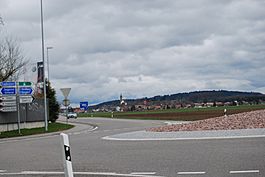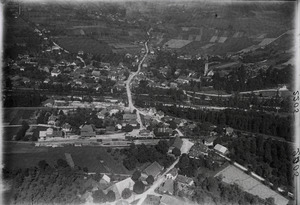Kirchberg, Bern facts for kids
Quick facts for kids
Kirchberg
|
||
|---|---|---|

Kirchberg village from a nearby roundabout
|
||
|
||
| Country | Switzerland | |
| Canton | Bern | |
| District | Emmental | |
| Area | ||
| • Total | 9.05 km2 (3.49 sq mi) | |
| Elevation | 505 m (1,657 ft) | |
| Population
(Dec 2020 )
|
||
| • Total | 5,919 | |
| • Density | 654.0/km2 (1,693.9/sq mi) | |
| Postal code |
3422
|
|
| Surrounded by | Aefligen, Burgdorf, Ersigen, Lyssach, Rüdtligen-Alchenflüh, Utzenstorf, Wynigen | |
Kirchberg is a town in Switzerland, located in the canton of Bern. It's part of the Emmental district, known for its beautiful landscapes. The town sits on the right bank of the Emme river and is a mix of industrial areas and quiet, rural spots.
Contents
History of Kirchberg
Kirchberg was first mentioned way back in 994. Over the years, some parts of Kirchberg became separate villages, like Guetisberg in 1704, Bickigen in 1911, and Rumendingen in 1953.
Early Settlements and Town Rights
People lived in the Kirchberg area long ago. Tools from the Neolithic (New Stone Age) and Bronze Age have been found. The village and its church were first mentioned in 994. At that time, a noblewoman named Adelheid gave them to Selz Abbey in France.
In the 13th century, a local noble family, the Barons of Thornberg, looked after Kirchberg. In 1283, Ulrich von Thornberg helped Kirchberg get a special town charter from King Rudolph I. This charter gave Kirchberg rights similar to the city of Bern, including permission to hold a weekly market. However, the town stayed quite small.
Bern Takes Over
In 1398, the town and its surrounding area were given to a monastery called Thorberg Chapterhouse. Later, in 1429, the city of Bern bought this area. By 1481, Bern owned all of Kirchberg. From 1471, Kirchberg was managed by the main official of Burgdorf.
The village church, first named in 1208, was rebuilt in 1506–7. It was very important and had rights to collect taxes from a large area.
Industry and Modern Growth
In the 1700s, some business owners moved from Burgdorf to Kirchberg. They started factories, like a bleaching plant in 1765 and a textile printing plant in 1784. A large trading business also opened before 1750. A rich industrialist, Johann Rudolf Tschiffelis, built a beautiful manor house called Kleehof in 1765–68. Today, this house is a very important national heritage site.
Between 1816 and 1843, Burgdorf tried to stop Kirchberg from holding markets. But once these rules were lifted, and with the opening of the Kirchberg train station in the 1870s, the town's economy boomed. A textile mill opened in 1871, and an aluminum factory and weaving factory opened in 1890.
In 1945, plans for an airport were stopped. But 20 years later, the A1 motorway was built nearby. This highway connection helped Kirchberg grow even more, bringing in new people and businesses. While Kirchberg is now an industrial and commercial town, the nearby small village of Bütikofen has remained mostly rural with farms and forests.
Geography of Kirchberg
Kirchberg covers an area of about 9 square kilometers (3.5 square miles). A large part of this land, about 44.7%, is used for farming. Forests cover about 32.5% of the area. The rest of the land, about 21.2%, has buildings and roads. A small part (1.4%) is rivers or lakes.
Most of the built-up area is for houses and other buildings (11.2%), and roads (6.1%). Industrial buildings make up 1.9% of the total area. All the forested land is covered with thick forests. For farming, most land is used for growing crops (29.5%) or for pastures (13.4%).
The town is located on the right side of the Emme river. It includes the main village of Kirchberg, a small area near the river, and the small village of Bütikofen.
In 2010, Kirchberg joined a new administrative district called Verwaltungskreis Emmental.
Kirchberg's Coat of Arms
The coat of arms for Kirchberg shows a silver church with a red roof on top of three green hills, all on a blue background. This design is a great example of canting arms. This means the picture on the shield helps explain the name. Kirche means "church" in German, and Berg means "mountain." So, it's a "church mountain"!
People and Population
Kirchberg has a population of about 5,700 people. About 12.7% of the people living here are foreign nationals. Over the last 10 years, the population has grown by about 5.5%. Most of this growth comes from people moving into the town.
Languages Spoken
Most people in Kirchberg (about 90.9%) speak German as their main language. Italian is the second most common language (3.0%), followed by Albanian (1.2%).
Age Groups
In 2010, children and teenagers (up to 19 years old) made up about 20.1% of the population. Adults (20–64 years old) made up 62.9%, and seniors (over 64 years old) made up 17%.
Population Growth Over Time
The chart below shows how Kirchberg's population has changed over many years:

Important Heritage Sites
The Kleehof, a historic manor house, is listed as a very important Swiss heritage site of national significance. This means it's a special place that is protected because of its historical and cultural value. The entire small village of Bütikofen is also part of the Inventory of Swiss Heritage Sites, recognized for its traditional look.
Economy and Jobs
In 2011, Kirchberg had a low unemployment rate of 2.47%, meaning most people who wanted jobs had them. In 2008, there were 2,374 people working in the town.
Types of Jobs
Jobs in Kirchberg are divided into three main groups:
- Primary Sector: This includes jobs related to nature, like farming. About 82 people worked in this area.
- Secondary Sector: This involves making things, like in factories or construction. About 1,078 people worked in manufacturing (76.9%) and construction (22.4%).
- Tertiary Sector: This covers service jobs, like in shops, transport, hotels, education, and healthcare. About 1,214 people worked in this sector. Many worked in sales, transport, or as professionals like scientists.
Many people who live in Kirchberg also travel to other towns for work, and many people from other towns come to work in Kirchberg. About 13.3% of workers used public transportation to get to work, and 58.2% used a private car.
Religion in Kirchberg
Based on the 2000 census, most people in Kirchberg (70.2%) belonged to the Swiss Reformed Church (a Protestant church). About 13.0% were Roman Catholic. Other groups included various Christian churches, Islamic people (5.05%), and a small number of Jewish, Buddhist, and Hindu individuals. About 5.26% of the population did not belong to any church.
Education in Kirchberg
In Kirchberg, many adults have completed higher education. About 41.1% have finished non-mandatory high school, and 12.7% have gone on to university or a specialized college.
School System
The school system in the Canton of Bern works like this:
- One year of non-required Kindergarten.
- Six years of Primary school.
- Three years of required lower Secondary school, where students are grouped by their abilities.
After secondary school, students can continue their education or start an apprenticeship (on-the-job training).
Student Numbers
During the 2010–11 school year, 689 students attended schools in Kirchberg.
- There were 5 kindergarten classes with 93 students.
- There were 18 primary classes with 333 students.
- There were 14 lower secondary classes with 263 students.
Some students in Kirchberg schools were from other countries or spoke a different language at home.
In 2000, 285 students came to Kirchberg for school from other towns, while 207 students from Kirchberg went to schools outside the town.
Images for kids
See also
 In Spanish: Kirchberg (Berna) para niños
In Spanish: Kirchberg (Berna) para niños






